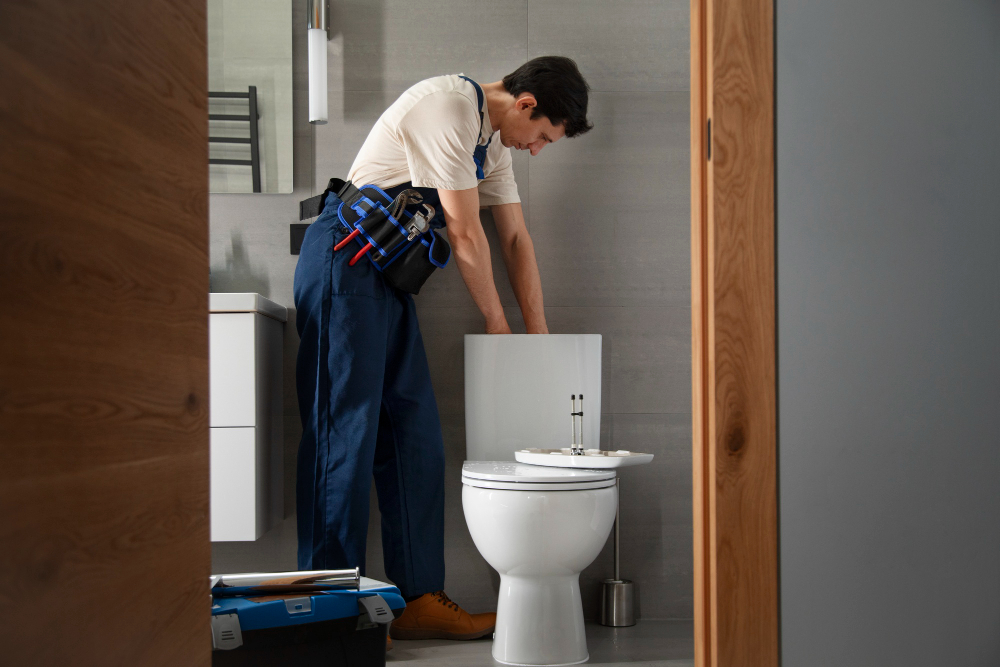
Have you ever experienced the annoyance of a clogged toilet? It often seems to happen at the most inconvenient times, such as when you have guests over or are in a hurry to get somewhere.
Picture yourself in your daily routine when, all of a sudden, the toilet water begins to rise perilously close to overflowing. Anxiety kicks in as you understand that something has gone wrong. In that instant, it may seem like a minor catastrophe has interrupted your tranquillity at home.
Understanding how to unclog a toilet can transform that moment of chaos into a manageable task, allowing you to restore normalcy and peace of mind quickly. This article will explore several effective ways to unblock a toilet.
You shouldn’t wait for your toilet to become blocked entirely before you act. Several signs can help you identify an impending clog and prevent it from occurring or worsening.
The three key signs to watch for toilet clogging are:
If the water drains slowly from the bowl after you flush, your toilet may start clogging.
If the water doesn’t fill back up in the bowl after you flush, there might be an issue with air circulation in the waste pipes.
If the water level in the bowl rises when you flush, it indicates a complete blockage that needs immediate attention.
If you notice any such problematic signs, act fast. Delaying can make the issue worse and more expensive to resolve. To check for slow drainage, flush the system thoroughly in the toilet.
If the water is draining slowly, try flushing again only if the water level is normal or low.
Don’t flush if the water level is high. If flushing doesn’t work, consider using a chemical cleaner or a toilet unblocker. Remember, toilets connected to a septic tank or cesspit can get clogged if they’re too full, so it’s best to contact a professional for emptying it.
Unclogging a toilet is one of the most unpleasant and messy household chores. Here are some of the methods for unblocking a clogged toilet successfully.
Here’s a look at the tools you’ll have at your disposal need:
Below are the Effective Ways to Unblock a Clogged Toilet:
You can frequently unclog toilets without needing tools such as a plunger or a drain snake. Many clogs include toilet paper, waste, and items that shouldn’t be flushed, such as baby wipes and feminine hygiene products.
You can often clear these clogs with chemicals instead of manual methods. However, if a toy or personal item, like a watch, is stuck, the approach may need to change.
If you think the clog isn’t serious, use hot water. Although boiling water works well for clearing other drains like sinks and showers, avoid using it in the toilet, as it could melt or crack the bowl.
Pour the hot gently into the toilet bowl from a comfortable waist-level height. Pouring from a higher position can help break up the clog.
If dish soap isn’t quite cutting it, why not try a little baking soda and vinegar magic? Start by putting one cup of baking soda in the bowl, then add vinegar. Close the toilet lid and let the mixture sit for 10 to 20 minutes.
The bubbling will help break down debris in the drain. Once it settles, pour approximately half a gallon of hot water into the bowl to push any leftover debris down the drain.
If your toilet is clogged, repeated flushing won’t help solve the problem. The water level will rise, which can lead to overflow. First, close the flapper in the tank to stop the water supply. This will prevent an overflow.
Lift the tank lid, and you’ll see a plug-like object attached to a chain at the bottom. Once you locate the flapper, press it down. The flapper lets water flow out of the tank. Flapper designs, sizes, and fits may differ based on the toilet type.
A chain links the flapper to the toilet lever, which raises the flapper and allows water to fill the bowl. Once the tank is empty, the flapper closes to prevent water from escaping, and the fill valve refills the tank with fresh water.
Enzyme cleaners utilise enzymes and live bacteria to break down waste debris. They provide a secure and eco-friendly option compared to harsh chemicals. Conventional drain cleaners can damage your plumbing system and pose risks to your family.
Although tackling a blockage with bleach can be tempting, enzyme cleaning agents are a much safer option. You can also make your DIY enzyme solution using the recipe below:
Cut the fruit peels into small pieces. Pour all the ingredients into a 2-litre bottle (like a soft drink bottle) and shake it well. Please note the date you prepared your enzyme cleaner; it will take approximately a month to become ready.
During this time, open the bottle and shake the mixture twice daily to let out carbon dioxide. After a month, strain the fruit peels and pour the liquid into a new spray bottle. It’s prepared for your use and can be easily kept at room temperature.
Plastic wrap can assist in unclogging a toilet. Start by placing a tightly stretched layer of plastic wrap over the toilet seat. Then, flush the toilet.
The wrap will create a wonderful vacuum, resembling a plunger. It’s normal if it inflates or bubbles during the flush, as this shows it’s working.
For the best results, use a fold-out rubber plunger to create a vacuum seal around the toilet bowl. A good rubber seal helps ensure the plunger clears the blockage effectively. Gently push the plunger into the toilet, then pull it back slowly for better suction.
This should help loosen the blockage. Keep doing this until you hear the water moving through the pipe, clearing the blockage. Once visibility is restored, it’s safe to flush the toilet again, and you should observe clean water in the bowl.
If the plunger isn’t effective, don’t worry. If you haven’t done so, consider acquiring a drain unblocker wire. This flexible rod has a spring probe head designed to navigate through blockages in tight bends. Often referred to as a plumbing snake, it moves similarly to a snake through the toilet curves.
If you’re a DIY enthusiast facing a clogged toilet, try using a plumber’s snake or a coat hanger to clear the blockage before calling a professional plumber. This approach is beneficial if something hard has become stuck in the toilet.
A drain snake is a handy little tool made from flexible metal, featuring a comfortable handle on one end. You simply insert the snake into the drain and give the handle a turn to break up or remove any clogs. If you lack a drain snake, a metal coat hanger serves as an effective alternative:
When faced with a clogged toilet, it’s essential to remain calm and address the issue strategically. Start with a plunger to remove the blockage. If that doesn’t work, try a toilet auger for tougher clogs. Should the issue continue, it’s advisable to consult a professional plumber to avoid damaging your system.
We are providing professional handyman services across Virginia including Sterling, Leesburg, Fairfax, Great Falls, Ashburn, and Centreville.

Get the latest updates via email. Don’t miss it. Any time you may unsubscribe.